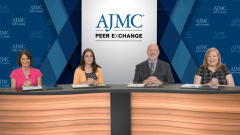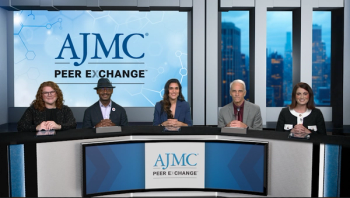
Pipeline Treatments for Schizophrenia
Future therapies for the treatment of schizophrenia are explored by a panel of key opinion leaders.
Episodes in this series

John J. Miller, MD: The pipeline as it’s evolving has come full circle; when we began, I talked about how chlorpromazine was our first drug to treat positive symptoms in 1954. The sad part of the story, at least for me, is that all antipsychotic drugs up to and including today that are FDA approved continue primarily to block one specific dopamine receptor. And it continues to create a lot of adverse events, as we’ve discussed throughout this panel discussion. What I find exciting is, specifically in psychopharmacology, we have 2 new drugs that are in the late stages of development. And one of them works on acetylcholine receptors in the brain that don’t bind to dopamine at all. We’ll see when all the data is reviewed, but they possibly may not only help with the positive symptoms but also with cognitive symptoms, which kind of makes sense since acetylcholine is such an important cognitive neurotransmitter. And the other drug works on a receptor that we never even knew existed until 2001: it’s called the TAAR1, or Trace Amine Associated Receptor Type 1. And this is a whole novel way of understanding how brain cells in circuits regulate the release of neurotransmitters. And again, no contact with any dopamine receptors, but depending on the microenvironment of dopamine concentrations, these receptors may impact decreasing or increasing release. So that’s on the near horizon. On the far horizon, we have a lot to do. And although there are many ways beyond medications to help with cognitive and negative symptoms, we know that, for example, agonizing the histamine [H3] receptor seems to have some precognitive and pro-alertness effects. And we know that the nicotinic cholinergic receptors are also important, and there have been attempts to find drugs that use these approaches to help with cognition, but they haven’t been all that successful. Alongside those is our whole expansion into understanding the glutamate in the GABA system. So from a pharmacological pipeline perspective, my hope is over the next 10 to 20 years, we really increase our portfolio of medications in all 3 of the domains, positive, negative, and cognitive, of course, to be used in conjunction with the larger interventions we spoke about.
It’s been a delight working with our panel here. And before we close, what I’d like to do is allow each of us to share what you see as the most exciting advances in the overall treatment of schizophrenia as we move forward. Carlos, why don’t we start with you?
Carlos Larrauri, APRN: One thing I’m excited about is the Accelerating Medicines Partnership [AMP] Schizophrenia program. I am cochair of the steering committee. And AMP Schizophrenia is a public-private partnership that’s investing over $100 million dollars to catalyze medical innovation, particularly drug development for people at risk for schizophrenia. Essentially, what we’re trying to discover are biomarkers and tools that will expedite the development of new medications. One thing that’s particularly interesting about this program is that we’re embedding lived experience. We’re embedding the patient and advocacy perspective from the initial point all the way to the end, to ensure that our program’s efforts are in line with the needs of the people we serve. In other words, we want to bridge science and real-world needs. We want to create medicines and innovations that matter and that are important to what patients care about.
John J. Miller, MD: Well, thank you. And Sandy, would you like to offer your perspectives?
Sandy Dimiterchik: Yes, I am interested in what’s going to happen with training for social skills. I recently found a former special education teacher who just in the last month started her own business where she’s working with adults and helping them with social skills and employment. She has her master’s in special education. And I’ve invited her to be a guest speaker at a career chat, a monthly Zoom video I do. I’m really interested in that probably for myself. Therapy’s great and CBT [cognitive behavioral therapy] and DBT [dialectical behavior therapy] are great, but when it comes down to it, not only do you need to be able to get the job, you need to be able to keep the job. I’m also a certified career coach, so it’s my passion. The other thing is, along the subject of social skills, I’m going to be interviewing Dr Kim T. Mueser [PhD], who is a coauthor of Social Skills Training for Schizophrenia. And they’re having their third edition come out in the next year. So I’m excited to see what that’s going to be about. And the other thing is cognitive remediation. I have an interview with Dr Susan R. McGurk [PhD] about a book she was the primary author on, helping people with employment. So I think that’s an area that really needs a lot of research and training.
John J. Miller, MD: Agreed. Thank you. And Dr Jones?
Nev Jones, PhD: I would go for the thinking and implementation work happening around learning health care systems broadly as well as specifically as it relates to SMI [serious mental illness]. And the idea behind a learning health care system is that it’s real, it’s practice based. It’s within an actual clinical delivery system, but really thinking about how to do integrative quality improvement, implementation, measurement-based care and in a way that fundamentally includes patients and other stakeholders as drivers, as decision makers, and influencing what happens through patient-facing data collection, patient-centered outcomes measurement. For example, we see 2 very exciting developments in terms of NIMH [the National Institute of Mental Health] support for the EPINET [Early Psychosis Intervention Network] initiative, which has already actualized large-scale learning health care systems across the United States in community settings where the learning is happening in the community focused on early psychosis. And the next iteration of this is going to be through CCBHCs, or the Certified Community Behavioral Health [Clinics], which look to become in many states the mainstay of treatment for people with SMI. So I think really making those, the CCBHC architecture in the United States function as both a regional and ultimately national learning health care system, I think could really transform things. And it provides a modality through which to deliver an array of best practices in an individualized way that makes sense to the individual. And that addresses a lot of the perpetual funding and billing issues we run into, especially in CCBHCs where the funding structure for the CMS [Centers for Medicare & Medicaid Services] CCBHC model is all about bundling and alternative payment structures.
John J. Miller, MD: Great. Thank you. And Dr Carney?
Caroline P. Carney, MD, MSc, FAPA, FAPM, CPHQ: Three things quickly; the first is the increase in federal funding coming into the area, into adolescent mental health and other areas post-COVID-19. I am super excited about that. The second is alternative models of care, like collaborative care and the CCBHCs to provide better access to evidence-based care to individuals. And the third is in the novel development of new pharmacotherapies, new social types of therapies, and other novel forms of therapy like virtual care and digital therapeutics.
John J. Miller, MD: Another approach to hopefully helping with cognitive and possibly negative symptoms is drugs that would inhibit the glycine transport pump. And by inhibiting the glycine transport pump, it would increase the level of glycine near the NMDA [N-methyl-D-aspartate] glutamate receptor, which will help it fire better. And I mentioned glutamate as an area in psychiatry that’s grown tremendously, and glycine and glutamate both need to be present for that NMDA glutamate receptor to fire. The potential there is helping with symptoms like cognition, motivation, learning, and memory.
Transcript edited for clarity.
Newsletter
Stay ahead of policy, cost, and value—subscribe to AJMC for expert insights at the intersection of clinical care and health economics.








































